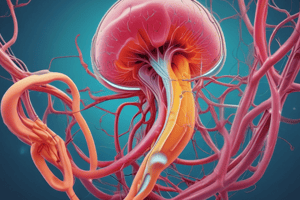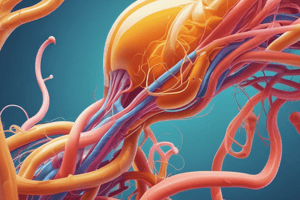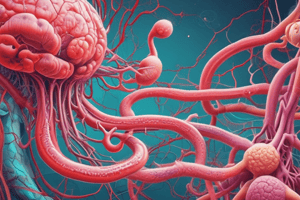Podcast
Questions and Answers
What is the active form of vitamin D?
What is the active form of vitamin D?
- Calcitriol (correct)
- Vitamin A
- Vitamin K
- Vitamin C
What is the primary hormone responsible for increasing erythrocyte production?
What is the primary hormone responsible for increasing erythrocyte production?
- Erythropoietin (EPO) (correct)
- Insulin
- Aldosterone
- Cortisol
What happens if there is inadequate vitamin D in the body?
What happens if there is inadequate vitamin D in the body?
- Development of osteoporosis (correct)
- Increased muscle growth
- Improved vision
- Enhanced memory function
Which of the following is NOT a hormone involved in regulating blood pressure by the kidneys?
Which of the following is NOT a hormone involved in regulating blood pressure by the kidneys?
What is the function of EPO produced in the kidneys?
What is the function of EPO produced in the kidneys?
What is the function of the glomerulus in the nephron?
What is the function of the glomerulus in the nephron?
What does the presence of leukocytes in urine indicate?
What does the presence of leukocytes in urine indicate?
Which factor does NOT affect the color of urine?
Which factor does NOT affect the color of urine?
What is polyuria?
What is polyuria?
What is the specific gravity of pure water?
What is the specific gravity of pure water?
How do ketones in urine indicate a health condition?
How do ketones in urine indicate a health condition?
What is the main mechanism through which many solutes are transported with sodium?
What is the main mechanism through which many solutes are transported with sodium?
Which structure recovers much of the water and some sodium that is still in the nephron?
Which structure recovers much of the water and some sodium that is still in the nephron?
What does Urea do as water leaves at the bottom of the Loop of Henle?
What does Urea do as water leaves at the bottom of the Loop of Henle?
Which hormone increases the number of sodium pumps in the Distal Convoluted Tubule (DCT)?
Which hormone increases the number of sodium pumps in the Distal Convoluted Tubule (DCT)?
What plays a large role in adjusting how much water is reabsorbed in the collecting ducts?
What plays a large role in adjusting how much water is reabsorbed in the collecting ducts?
Which hormone works to inhibit aldosterone and allows for excretion of water?
Which hormone works to inhibit aldosterone and allows for excretion of water?
What causes vasoconstriction and reduces the amount of blood flowing to the glomerulus?
What causes vasoconstriction and reduces the amount of blood flowing to the glomerulus?
Which system is important for kidney function and involves the release of aldosterone due to increased angiotensin 2 levels?
Which system is important for kidney function and involves the release of aldosterone due to increased angiotensin 2 levels?
What triggers the release of vasopressin to reabsorb water?
What triggers the release of vasopressin to reabsorb water?
What is one of the effects of caffeine on the nephron?
What is one of the effects of caffeine on the nephron?
What is the medical term for urination?
What is the medical term for urination?
Which structure prevents large objects like cells and proteins from passing into the nephrons?
Which structure prevents large objects like cells and proteins from passing into the nephrons?
What is released in response to flow rate or sodium disturbances?
What is released in response to flow rate or sodium disturbances?
Which structure regulates renin release to influence blood volume?
Which structure regulates renin release to influence blood volume?
What does ADH cause in the collecting ducts?
What does ADH cause in the collecting ducts?
What is the function of aquaporin channel proteins in the collecting ducts?
What is the function of aquaporin channel proteins in the collecting ducts?
What happens if too many proteins get into the urine?
What happens if too many proteins get into the urine?
What does systemic edema indicate?
What does systemic edema indicate?
Flashcards are hidden until you start studying
Study Notes
Urinary System Structure
- The female urethra is approximately 4cm long, making it more prone to infections and UTIs.
- The male urethra is approximately 20cm long and passes through the prostate gland.
- The bladder collects urine from both ureters and can hold around 600mL of urine.
- The ureters are approximately 30cm long and transport urine from the kidneys to the bladder.
Urination and Micturition
- Micturition is the medical term for urination.
- The urge to urinate is first felt when the bladder contains around 150mL of fluid.
- Urine is formed in the kidneys and propelled into the bladder through the ureters.
Kidney Function
- The kidneys are approximately the size of a fist and receive around 25% of cardiac output while at rest.
- Blood flow to the kidneys comes from the descending aorta and exits to the inferior vena cava.
- The right kidney sits slightly lower than the left kidney due to the liver's placement.
- Nephrons in the kidney make urine, which flows through ducts and empties into the ureters.
- Capillaries recover most of the solutes and water from the nephron and return them to circulation.
Nephron Function
- Nephrons work through filtration, reabsorption, and secretion.
- Filtrate goes from the capillary to Bowman's capsule easily due to filtration slits and fenestrated capillaries.
- Fenestrations prevent large objects like cells and proteins from passing into the nephrons.
- Positively charged filtrate passes through more easily.
- The basement membrane prevents medium-sized objects from passing through.
- The macula densa regulates renin release to influence blood volume.
- Nephrons also have many microvilli to absorb and secrete solutes.
- They have many mitochondria to produce enough ATP.
Urine Formation and Regulation
- The glomerular filtration rate is the amount of filtrate produced per minute.
- Fluid is absorbed into Bowman's capsule due to hydrostatic and osmotic pressure.
- Osmotic pressure in the blood is important to prevent excessive water loss or retention.
- ADH regulates water reabsorption in the collecting ducts.
- Without ADH, aquaporin channels are not inserted into the membrane.
- Most cells have aquaporin molecules for water transport.
- The kidneys regulate blood pressure, osmolarity, and electrolyte balance.
- They also regulate pH levels and recover electrolytes like sodium, potassium, and calcium.
Urine Characteristics
- Urine is affected by water intake, exercise, environmental temperature, nutrient intake, and other factors.
- Urinalysis is done to determine urine content.
- Color is affected by some foods, bile obstruction, dehydration, or bleeding.
- Specific gravity is the amount of solutes in the urine.
- Leukocytes in the urine indicate a urinary tract infection.
- Ketones in the urine mean that the body is using fat for energy in preference of glucose or that the diet is low in carbs and proteins.
- Nitrates are normally found in the urine.
- We must produce at least 500mL of urine each day to get rid of wastes.
- Anuria is the absence of urine production, polyuria is the overproduction of urine, and oliguria is the term for renal disease causing little urine production.
Hormonal Regulation
- The renin-angiotensin-aldosterone system is important for kidney function.
- Aldosterone is released due to angiotensin 2 or increased potassium levels.
- Progesterone binds to receptors like aldosterone, but it is much weaker.
- Anti-diuretic hormone (ADH) is also called vasopressin and it works to reabsorb water.
- Endothelins are powerful vasoconstrictors found in the kidneys.
- Natriuretic hormones work to inhibit aldosterone and let sodium leave, resulting in water excretion.
- Parathyroid hormone influences calcitriol and will result in higher calcium levels in the blood.
Blood Pressure Regulation
- Blood pressure reflects blood volume and is measured in the aorta and carotid sinuses.
- Baroreceptors send signals to the central nervous system for a sympathetic or parasympathetic response.
- Diuretics increase urine volume.
- Caffeine promotes vasodilation in the nephron and inhibits ADH.
- Glucose in the urine will increase water in the urine, as in the case of a person with uncontrolled diabetes.
Studying That Suits You
Use AI to generate personalized quizzes and flashcards to suit your learning preferences.




